The purpose was to allow the barrel threads to be greased
to facilitate removal of the barrel at a later date.
| Mosin Nagant Rifle Receiver Variations All content copyright © 7.62x54r.net Return to Mosin Nagant Theories, Opinions, and Observations |
Introduction Most of those with even a passing interest in Mosin Nagant rifles are aware that there are hex and round receivers. Also, that there is a "war time expedient" round receiver commonly known as a "high wall". However, even many experienced Mosin enthusiasts aren't aware that in fact there are over eighteen distinct receiver variations. This page shows the differences and identifies the arsenals and time frames of their production. Numbers are assigned to the receiver types and terms coined for the different features. These numbers and terms are purely arbitrary and have no relationship to official designations or even systems used by other researchers in published works. This research is based on a limited collection and it is entirely possible that other variations exist. In some cases post production work was done, or is suspected to have been done, on the receiver and it is not in it's original configuration. In at least one case this involved a new barrel dated later than the receiver and from a different arsenal. These will be pointed out in the text below as will one of a kind examples that do not show evidence of post production work. The latter could be in fact altered post production, evidence of a short transition period, simply a production "mistake" or one of many that have not surfaced. (?) indicates that an example of this model has not been documented but it is only reasonable that it exists since it was produced concurrent with the known examples of other models.
Photographs of distinct features These pictures are placed here to help define the terms used in the text below. Because many of them pertain to several different receiver variations they are grouped together rather than repeated for each receiver description.
Hex |
| Round |
| Tapped, and plugged hole The purpose was to allow the barrel threads to be greased to facilitate removal of the barrel at a later date. |
| Shallow magazine screw hole | Through magazine screw hole |
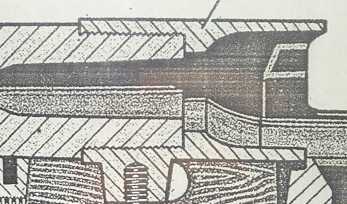 |
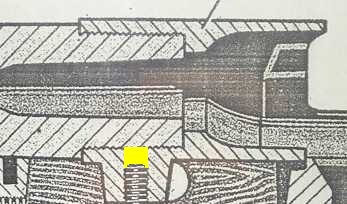 |
| The yellow in the line drawing above shows where the screw hole is drilled through to the barrel threads. | |
| Stepped Tang | Unstepped Tang |
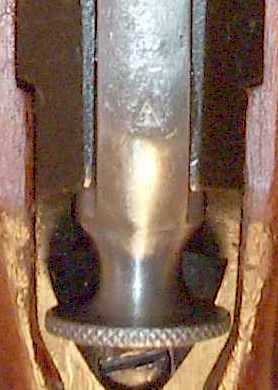 |
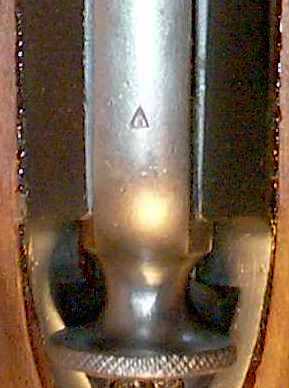 |
| Extra notch at stripper clip guide | No extra notch at stripper clip guide |
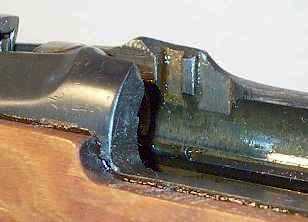 |
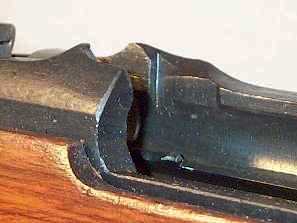 |
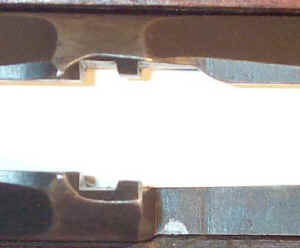 |
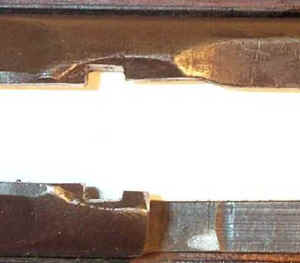 |
| High Wall |  |
| Low Wall | |
| Polish Low Wall |  |
| Machined right rear receiver | Unmachined right rear receiver | Semimachined right rear receiver, courtesy of rocker98 |
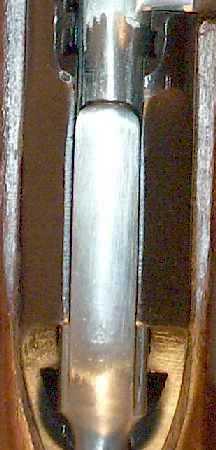 |
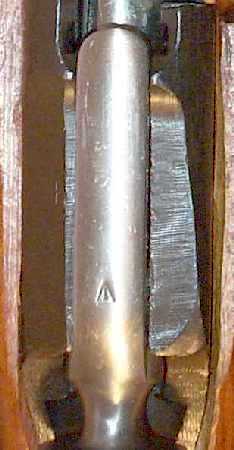 |
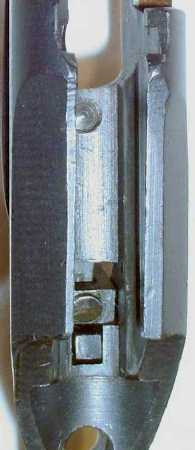 |
| Inner receiver ring | No inner receiver ring |
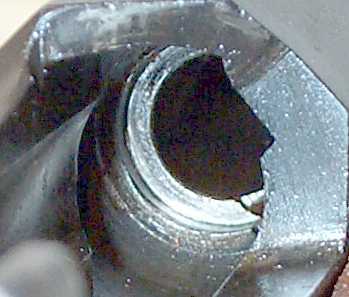 |
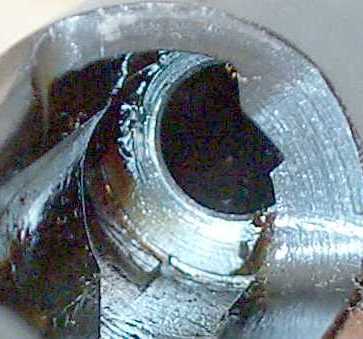 |
 |
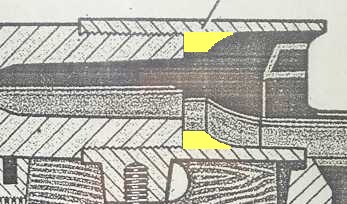 |
This is an often unnoticed receiver feature that probably did more to speed up production during WWII and afterwards than any of the other changes made over the long history of the Mosin design. It is obvious that it is much easier to cut a straight walled round hole from the muzzle end of the receiver than it is to increase the diameter of the hole after passing through a smaller diameter opening from either end of the receiver. Some hex receivers that do not have an inner receiver ring have been observed, but all of them have been rebarreled at a later date. The inner receiver ring was machined away as part of the rebarreling process and this is not a unique receiver style. The yellow in the line drawing above indicates the area that is not present in post 1941 receivers and reused earlier receivers. |
|
| Lug race not cut through | Lug race cut through |
| From the earliest production the bolt lug race stopped at the inner receiver ring and even when the inner receiver ring was dropped from production the cut stopped at the same point. In some later production the lug race extends all the way to the front of the receiver right through the threads that receive the barrel. This feature is easily overlooked and is unique in that it does not appear to follow a regular pattern of use. Among Soviet made receivers the race is cut through only on those produced at Izhevsk and was not on Tula production. This cut first appears in 1942 and continues into 1943 but appears to stop as there are 1943 receivers without the cut. In late 1943 the right rear began to be machined as seen above and to date none of these have been documented with the race cut. In 1944 there are receivers with and without the cut which would seem to indicate that it comes back into use some time later in that year. However, in 1945 there are also receivers with and without the cut. This seems to indicate an intermittent use of this feature in the 1944 and 1945 period. All observed Soviet receivers dated 1946 and later have the cut which indicates that it was standardized by then. Also interesting is the fact that Polish and Hungarian receivers do not have the cut while Romanian and Chinese receivers do. | |
Receiver #0.5 1891-1893?
(The confirmation of the tapped and plugged hole at the four arsenals in
production during this era was made after this page was initially created, hence the
"0.5" designation.)
Chatellerault, Sestroryetsk, Tula and Izhevsk arsenals
M91 model
This original configuration is commonly known as a "hex receiver". Besides the obvious polygonal shape of the exterior of the receiver itself, it has a tapped and plugged hole next to the recoil lug, a shallow magazine screw hole, stepped tang, extra notch forward of the stripper clip guide, low wall, machined right rear, and inner receiver ring without the lug race cut.
Receiver #1 1893?-1935 (Izhevsk) and 1936 (Tula)
Chatellerault, Sestroryetsk, Tula, Izhevsk, Remington and New England Westinghouse
arsenals
M91, Dragoon, Cossack, and M91/30 models
Shortly after initial production the tapped and plugged hole next to the recoil lug was dropped. All other sub features remained the same until the adoption of the round receiver. This receiver type had the longest production run without any changes to the sub features.
Receiver #2 1935 (Izhevsk) and 1936 (Tula)-1939
Tula and Izhevsk arsenals
M91/30 model
The round receiver was adopted along with the model M91/30 in 1930, but did not go into production until 1935 and 1936 at Izhevsk and Tula respectively. It retained all the same sub features as the hex receiver (#1); shallow magazine screw hole, stepped tang, extra notch forward of the stripper clip guide, low wall, machined right rear, and inner receiver ring without the lug race cut. All future Mosin receivers are round and no hex receivers are known to have been produced after 1936. Any rifles or carbines with a hex receiver and a barrel date after 1936 were built on older receivers. One exception is a few 1937 rifles built on 1936 receivers.
Receiver #2.5 1938-1941
(The two different types of magazine screw holes were defined after this page was
initially created, hence the "2.5" designation)
Tula and Izhevsk arsenals
M91/30 and M38 models
In late 1938 the magazine screw hole no longer stopped short, but was drilled through to the barrel threads. There is some overlap of this feature between the two years with a later pattern Izhevsk dated 1938 and an earlier pattern Izhevsk dated 1939 observed. Thus the overlap in dates for types #2 and #2.5. All other features remained the same as the 1936-1939 (#2) production. All future Mosin receivers have the magazine screw hole drilled through.
Receiver #3 ?1938-1939?
Tula arsenal
M91/30 PEM side rail mount sniper model
This receiver was adopted in the late 1930's to allow for a side rail scope mount and is unique to snipers of this era. A 1938 Tula of this type is documented, but it is presumed that it was also used in 1939 just as the standard receiver (#2) was. The only difference between it and the standard round receiver (#2) is that it is a high wall. It retained the shallow magazine screw hole, stepped tang, extra notch forward of the stripper clip guide, machined right rear, and inner receiver ring without the lug race cut.
Receiver #3.5 ?1939-1940?
(The two different types of magazine screw holes were defined after this page was
initially created, hence the "3.5" designation)
Tula arsenal
M91/30 PEM side rail mount sniper model
Just as with standard receiver (#2) production, in 1939 the magazine screw hole no longer stopped, but was drilled through to the barrel threads. All other features remained the same as the 1938 (#3) production. It is not confirmed, but very possible that the change took place in late 1938. Certainly no later than very early in 1939.
Receiver #4 1941
(Only one example)
Izhevsk arsenal
M91/30 model, possibly M38
As World War II began the Soviets began to look for ways to increase production of arms and reducing the number of machining steps required is a simple and logical way to do so. It seems that different steps were eliminated over a period of time, primarily in 1941. This rifle is the earliest observed without the steps at the tang or the inner receiver ring. These two features never reappeared in Izhevsk production. It does still have the extra notch forward of the stripper clip guide, a low wall, is machined at the right rear, and does not have the lug race cut.
Receiver #4.5 1941
(A few examples were found after this page was initially created, hence the
"4.5" designation)
Izhevsk arsenal
M38 model, possibly M91/30
Later in 1941 Izhevsk carried the streamlining process further by bringing back the high wall receiver for all rifle and carbine production, not just snipers. At this time the right rear was no longer machined. The left rear continued to be machined because it is necessary to hook the cocking knob on it to place the rifle on "safe". The extra notch forward of the stripper clip guide was was still in place, although apparently for a brief time, as this variation is uncommon.
Receiver #4.5.1 1941
(Only one example which does not fit a pattern of progression from more to less
refined machining but falls near the #4.5 variation, hence the "4.5.1"
designation)
Izhevsk arsenal
M38 model
This unique receiver has the low wall of the #4 and earlier variations and does not have the steps at the tang, inner receiver ring or the lug race cut just as #4. The right rear is not machined to the degree of the #4, but to a greater extent than the #4.5. However, it does not have the extra notch at the stripper clip guide which was retained by #4.5. Discounting the extra notch at the stripper clip guide this receiver would fit between #4 and #4.5 and discounting the right rear it would fit between #4.5 and #5. It is possible that this receiver was originally built as a #5 but was later machined into it's current configuration by removing the high wall and part of the right rear. This is a good illustration of the difficulty of fitting Mosin Nagant variations into clear cut categories and indicates that either some receiver changes were intermittent before they became standardized or some machining was done after initial production. Thanks to USMCsean of Gunboards.com for identifying this variation and providing the pictures.
| Receiver #4.5.1, courtesy of USMCsean |
 |
Receiver #4.5.2 1941
(Only one example which does not fit a pattern of progression from more to less
refined machining but falls near the #4.5 variation with subtle differences from the
#4.5.1, hence the "4.5.2" designation)
Izhevsk arsenal
M38 model
This unique receiver has a "semi-low wall" and partially machined right rear (similar to #4.5.1) that falls between the #4 and #4.5 receivers. It does not have the steps at the tang, inner receiver ring or the lug race cut just as #4. However, it does not have the extra notch at the stripper clip guide which was retained by #4.5. Discounting the extra notch at the stripper clip guide this receiver would fit between #4 and #4.5 and discounting the semi-low wall and right rear it would fit between #4.5 and #5. It is possible that this receiver was originally built as a #5 but was later machined into it's current configuration by partially removing the high wall and right rear. This is a good illustration of the difficulty of fitting Mosin Nagant variations into clear cut categories and indicates that either some receiver changes were intermittent before they became standardized or some machining was done after initial production. Thanks to lvmb of Gunboards.com for identifying this variation and providing the picture.
| Receiver #4.5.2, courtesy of lvmb |
 |
Receiver #5 1941-1943
Izhevsk arsenal
M91/30, M91/30 sniper, M38, and M44 models
The next change at Izhevsk after the high wall and unmachined right rear became standard was the elimination of the extra notch forward of the stripper clip. This type of receiver is by far the most commonly encountered of the WWII era and was used on the earliest M44s that were produced in 1943.
Receiver #5.0.1 1941
(Only one example which does not fit a pattern of progression from more to less
refined machining but falls near the #5 variation, hence the "5.0.1"
designation)
Izhevsk arsenal
M91/30 model
This unique receiver has the semi-low wall and partially machined right rear (similar to #4.5.2) that falls between the #4 and #4.5 receivers. It does not have the steps at the tang or inner receiver ring just as #4. However, it does not have the extra notch at the stripper clip guide which was retained by #4.5. Discounting the extra notch at the stripper clip guide this receiver would fit between #4 and #4.5 and discounting the semi-low wall and right rear it would fit between #4.5 and #5. Unlike #4.5.2 this receiver does have the lug race cut through which doesn't appear until #5.5. It is possible that this receiver was originally built as a #5.5 but was later machined into it's current configuration by partially removing the high wall and right rear. It is the only 1941 and earliest known example with the lug race cut through. This is a good illustration of the difficulty of fitting Mosin Nagant variations into clear cut categories and indicates that either some receiver changes were intermittent before they became standardized or some machining was done after initial production. Thanks to rocker98 of Gunboards.com for identifying this variation and providing the pictures.
| Receiver #5.0.1, courtesy of rocker98 | |
 |
|
 |
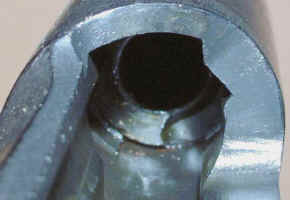 |
Receiver #5.0.2 1941/3
(Only one example which began as an Izhevsk #5 but was further machined by Tula
to more closely resemble the #7 pattern, hence the "5.0.2" designation)
Izhevsk/Tula arsenal
M91/30 PU sniper model
This receiver was originally produced at Izhevsk in 1941 in the #5 pattern with an unstepped tang, no extra notch forward of the stripper clip guide, a high wall, unmachined right rear, no inner receiver ring and the lug race not cut through. It was later used to build a 1943 Tula PU sniper and further machining was done. The tang is marked with the Izhevsk arsenal arrow in triangle mark and dated 1941. It also has the Tula arsenal star mark and a partial date of "4" which is presumed to be the first digit of "43". At Tula the right rear was machined and the extra notch at the stripper clip guide was added, as in all original Tula receiver production. The high wall was retained to accept the PU side rail mount. The steps at the tang were not added which would be a match of the #6 pattern and therefore it matches the later #7 pattern. There is also a possibility that this receiver began as a #4.5 which already had the extra notch at the stripper clip guide, but that variation is uncommon and the odds are against it. Regardless, this extra, and unnecessary, work done by Tula justifies it's reputation for careful craftsmanship and a higher degree of quality in spite of the pressures of war time production. However, a 1941 (redated from 1940) Tula barreled M91/30 built on a #5 1941 Izhevsk receiver with no modifications has also been documented. Whether the receiver was sent to Tula by Izhevsk or the barrel to Izhevsk by Tula is a mystery, but the tang is not remarked by Tula. For this and other rifles with receivers that don't match their barrel see the Soviet Mosin Nagants Built on Earlier Receivers page. Thanks to SturmGrenadier of Gunboards.com for identifying this variation and providing the pictures.
Receiver #5.0.2, courtesy of SturmGrenadier |
|||
 |
|||
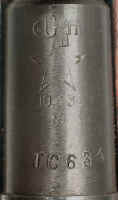 |
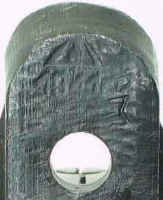 |
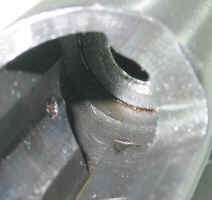 |
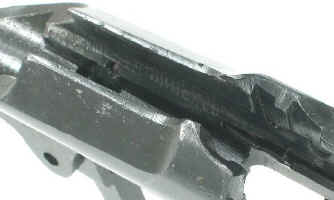 |
Receiver #5.5 1941-1943
(Examples were found after this page was initially created, hence the
"5.5" designation)
Izhevsk arsenal
M91/30, M91/30 sniper, and M38 models, possibly M44
The final change at Izhevsk was to cut the lug race all the way to the front of the receiver. Apparently this was done for a short period at this time as the cut was not made on later 1943 production with a reversion back to the previous receiver style (#5).
Receiver #5.5.1 1942/3
(Only one example which began as an Izhevsk #5.5 but was further machined by Tula
to more closely resemble the #7 pattern, hence the "5.5.1" designation)
Izhevsk/Tula arsenal
M91/30 PU sniper model
This receiver was originally produced at Izhevsk in 1942 in the #5.5 pattern with an unstepped tang, no extra notch forward of the stripper clip guide, a high wall, unmachined right rear, no inner receiver ring and the lug race cut through. It was later used to build a 1943 Tula PU sniper and further machining was done. The tang is marked with the Izhevsk arsenal arrow in triangle mark and dated 1942. It also has the Tula arsenal star mark and a partial date of "4" which is presumed to be the first digit of "43". This is very similar to Receiver #4.5.3 above with the exception of the beginning receiver pattern and the subsequent amount of work necessary to bring it up to Tula specifications. The only difference in the final pattern of the two is the lug race cut through which this one has and #4.5.3 does not. At Tula the extra notch forward of the stripper clip guide was cut as in all original Tula receiver production, but done somewhat crudely. The high wall was retained to accept the PU side rail mount, but the right rear was machined, also as in all original Tula receiver production. Of course the lug race cut was not replaced and this is the one feature that points toward Izhevsk production since it was never done on original Tula production receivers. The steps at the tang were not added which would be a match of the #6 pattern and therefore it matches the later #7 pattern. This extra, and unnecessary, work done by Tula justifies it's reputation for careful craftsmanship and a higher degree of quality in spite of the pressures of war time production. However, a 1941 (redated from 1940) Tula barreled M91/30 built on a #5 1941 Izhevsk receiver with no modifications has also been documented. Whether the receiver was sent to Tula by Izhevsk or the barrel to Izhevsk by Tula is a mystery, but the tang is not remarked by Tula. For this and other rifles with receivers that don't match their barrel see the Soviet Mosin Nagants Built on Earlier Receivers page.
| Receiver #5.5.1 | ||
 |
||
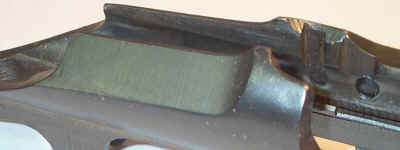 |
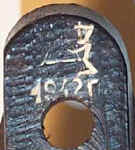 |
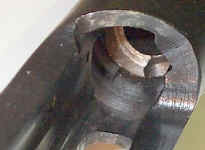 |
Receiver #6 1942-1943
Tula arsenal
M91/30, M91/30 sniper models
Tula was not as quick to change production methods as Izhevsk, and did not go as far with the changes. The first change was to make high wall receivers standard for non-sniper rifles along with the elimination of the inner receiver ring. The stepped tang was retained. The extra notch forward of the stripper clip guides and the machining at the right rear were also retained as they were through the end of Tula production in all models.
Receiver #7 1943-1944
Tula arsenal
M91/30, M91/30 sniper, M38, and M44 models
The next change Tula made was to eliminate the steps at the tang. All other features of #6 were retained, including the extra notch forward of the stripper clip guides, the high wall, the machining of the right rear, no inner receiver ring, and no lug race cut. This receiver type was used through the end of Tula production.
Receiver #8 1943-1945
Izhevsk arsenal
M91/30, M91/30 sniper(?), M38, and M44 models
As German pressure on the Soviets eased late in WWII some of the earlier expediencies were eliminated, or rather the extra steps in the machining process were reinstated. Just as they were phased in slowly, they were also phased out over time. In late 1943 Izhevsk began to machine the right rear of the receiver. The high wall was still in place, the tang remained unstepped, there was no extra notch forward of the stripper clip guides, there was no inner receiver ring and the lug race was not cut all the way through on most receivers.
Receiver #8.5 1944-1945
Izhevsk arsenal
M91/30, M91/30 sniper(?), M38, and M44 models
In 1944 the earlier feature of cutting the lug race all the way through to the front of the receiver returned. However, there are examples with and without the cut from 1944 and 1945 which indicates that this feature was intermittent. All other features remained the same as the previous receiver (#8).
Receiver #9 1945-1946
Izhevsk arsenal
M44 model
In late 1945 the low wall reappeared. The first post-war low wall receiver has the right rear machined but still lacks the extra notch forward of the stripper clip guides. As in all Izhevsk production after 1941 it does not have the steps at the tang or the inner receiver ring. It also has the lug race cut all the way through which became standard from this point forward.
Receiver #9.5 1946-1948
Izhevsk arsenal
M44 model
The final Izhevsk production receiver is interesting in that it shares the same set of features as later production in other countries that adopted the Mosin design. It is a round low wall with a through magazine screw hole, no steps at the tang, machining at the right rear, and no inner receiver ring with the lug race cut through. The feature that distinguishes it from #9 is the return of the extra notch forward of the stripper clip guides. The reason for this notch is not apparent and the reason for the change is unknown.
Receiver #9.8 1947
Izhevsk arsenal
M91/30 PU sniper model
Izhevsk produced a few M91/30 PU snipers post WWII. The high wall is the only difference between this receiver and post war Izhevsk M44 receiver production (#9.5). The only difference between this receiver and #8.5 is the notch at the stripper clip guide. Features on the round high wall include a through magazine screw hole, an unstepped tang, the notch forward of the stripper clip guides, machining at the right rear and no inner receiver ring with the lug races cut through.
Receiver #9.5b 1953-1961
(Identical features to #9.5, but different arsenals and time period)
Romania, China, Albania
M44, M91/30 (Romania), T53 (China), M91/30 (Albania) models
These Mosin clones share the same set of receiver features as the last low wall Izhevsk production. It is a round low wall with a through magazine screw hole, no steps at the tang, machining at the right rear, and no inner receiver ring with the lug race cut through.
Receiver #4b 1952-1953
(Identical features to #4, but different arsenal and time period)
Hungary
M44 model
The Hungarian production receiver is interesting in that it shares the same set of features as the unique 1941 "transitional" M91/30 (#4). It is a round low wall with a through magazine screw hole, no steps at the tang, machining at the right rear, and no inner receiver ring without the lug race cut through.
Receiver #5b 1951
(Identical features to #5, but different country, time period and a much higher
degree of finishing)
Hungary
M91/30 model (not sniper)
This interesting and uncommon rifle shares a set of receiver features with early WWII Izhevsk production, but shows a much higher degree of quality in the machine work. The high wall round receiver has a through magazine screw hole, is unstepped at the tang, unmachined at the right rear, has no notch forward of the stripper clip guides, and has no inner receiver ring without the lug race cut through. A low wall version from has been verified, but is not available for close observation. There is also a Hungarian M91/30 PU sniper version that would presumably have the same set of features.
| Nicely machined Hungarian M91/30 high wall |
Receiver #7b 1951
(Identical features to #7, but different arsenal and time period)
Poland
M44 model
The earliest Polish receiver production shares a set of features with 1943-1944 Tula production. The high wall round receiver has a through magazine screw hole, is unstepped at the tang, machined at the right rear, has the notch forward of the stripper clip guides, no inner receiver ring, and no lug race cut. This receiver type was short lived being replaced with the unique Polish low wall (#10) in the same year.
Receiver #10 1951-1955
Poland
M44 model
The final unique Mosin receiver type is found on Polish M44s. It has the same set of features as post war Izhevsk production "transitional" M44s (#9) with the exception of the lug race cuts and the distinctive low wall scallop. The low wall round receiver has a through magazine screw hole, is unstepped at the tang, machined at the right rear, has no notch forward of the stripper clip guides and has no inner receiver ring without the lug race cut through. Polish M91/30s have been reported, but none have been available for close observation.
Unique Polish M44 low wall scallop |
Summary chart of receiver features
| No. | Dates | Arsenal/ Country |
Models | hex/ round |
tapped hole |
shallow/ through magazine screw hole |
stepped/ unstepped tang |
notched/ un-notched at stripper guides |
low wall/ high wall |
machined/ unmachined at right rear |
inner receiver ring |
lug race cut through |
| 0.5 | 1891-1893? | All(note 1) | M91 | hex | yes | shallow | stepped | notched | low | machined | yes | no |
| 1 | 1893?-1935/6 | All(note 2) | M91, M91/30 | hex | no | shallow | stepped | notched | low | machined | yes | no |
| 2 | 1935/6-1939 | Izhevsk, Tula | M91/30 | round | no | shallow | stepped | notched | low | machined | yes | no |
| 2.5 | 1938-1941 | Izhevsk, Tula | M91/30, M38 | round | no | through | stepped | notched | low | machined | yes | no |
| 3 | 1938?-1939? | Tula | M91/30 sniper | round | no | shallow | stepped | notched | high | machined | yes | no |
| 3.5 | 1938?-1940? | Tula | M91/30 sniper | round | no | through | stepped | notched | high | machined | yes | no |
| 4 | 1941 | Izhevsk | M91/30 (M38?) | round | no | through | unstepped | notched | low | machined | no | no |
| 4.5 | 1941 | Izhevsk | M38 (M91/30?) | round | no | through | unstepped | notched | high | unmachined | no | no |
| 4.5.1 | 1941 | Izhevsk | M38 | round | no | through | unstepped | un-notched | low | semi(note 3) | no | no |
| 4.5.2 | 1941 | Izhevsk | M38 | round | no | through | unstepped | un-notched | semi | semi(note 4) | no | no |
| 5 | 1941-1943 | Izhevsk | All | round | no | through | unstepped | un-notched | high | unmachined | no | no |
| 5.0.1 | 1941 | Izhevsk | M91/30 | round | no | through | unstepped | un-notched | semi | semi(note 5) | no | yes |
| 5.0.2 | 1941/3(note 6) | Izhevsk/Tula | M91/30 sniper | round | no | through | unstepped | notched | high | machined | no | no |
| 5.5 | 1941-1943 | Izhevsk | M91/30, M38 | round | no | through | unstepped | un-notched | high | unmachined | no | yes |
| 5.5.1 | 1942/3(note 7) | Izhevsk/Tula | M91/30 sniper | round | no | through | unstepped | notched | high | machined | no | yes |
| 6 | 1942-1943 | Tula | M91/30 & sniper | round | no | through | stepped | notched | high | machined | no | no |
| 7 | 1943-1944 | Tula | All | round | no | through | unstepped | notched | high | machined | no | no |
| 8 | 1943-1945 | Izhevsk | All | round | no | through | unstepped | un-notched | high | machined | no | no |
| 8.5 | 1944-1945 | Izhevsk | All | round | no | through | unstepped | un-notched | high | machined | no | yes |
| 9 | 1945-1946 | Izhevsk | M44 | round | no | through | unstepped | un-notched | low | machined | no | yes |
| 9.5 | 1946-1948 | Izhevsk | M44 | round | no | through | unstepped | notched | low | machined | no | yes |
| 9.8 | 1947 | Izhevsk | M91/30 sniper | round | no | through | unstepped | notched | high | machined | no | yes |
| 7b | 1951 | Poland | M44 | round | no | through | unstepped | notched | high | machined | no | no |
| 10 | 1951-1955 | Poland | M44 | round | no | through | unstepped | un-notched | low | machined | no | no |
| 4b | 1952-1953 | Hungary | M44 | round | no | through | unstepped | notched | low | machined | no | no |
| 5b | 1951 | Hungary | M91/30 | round | no | through | unstepped | un-notched | high | unmachined | no | no |
| 9.5b | 1953-1955 | Romania | M44, M91/30 | round | no | through | unstepped | notched | low | machined | no | yes |
| 9.5b | 1953-1960 | China | T53 | round | no | through | unstepped | notched | low | machined | no | yes |
| 9.5b | 1961 | Albania | M91/30 | round | no | through | unstepped | notched | low | machined | no | yes |
| No. | Dates | Arsenal/ Country |
Models | hex/ round |
tapped hole |
shallow/ through magazine screw hole |
stepped/ unstepped tang |
notched/ un-notched at stripper guides |
low wall/ high wall |
machined/ unmachined at right rear |
inner receiver ring |
lug race cut through |
| Notes: 1. New England Westinghouse and Remington were not in production at this time. 2. Chatellerault production ended in 1895 and Sestroryetsk in 1918, Remington and New England Westinghouse were 1915 to 1918 only. 3. For a description and pictures of this receiver see Receiver #4.5.1 above, courtesy of USMCsean. 4. For a description and picture of this receiver see Receiver #4.5.2 above, courtesy of lvmb. 5. For a description and pictures of this receiver see Receiver #5.0.1 above, courtesy of rocker98. 6. For a description and pictures of this receiver see Receiver #5.0.2 above, courtesy of SturmGrenadier. 7. For a description and pictures of this receiver see Receiver #5.5.1 above. |
| All content copyright © 7.62x54r.net Return to Mosin Nagant Theories, Opinions, and Observations |